Panasonic Lumix DMC-FZ8 Review
Panasonic Lumix DMC-FZ8
With 12x zoom and image stabilisation, the FZ8 looks like a winner
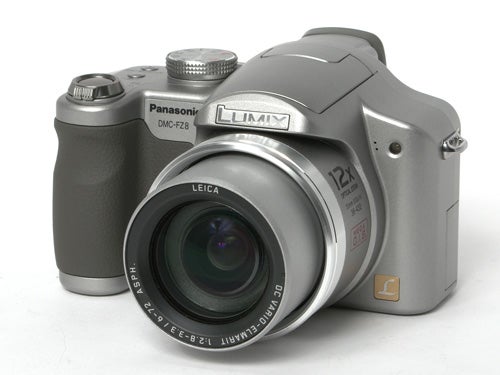
Verdict
Key Specifications
- Review Price: £212.00
If you’re looking for a high-end superzoom camera with image stabilisation, you don’t have to look very far. Basically your choices are the Kodak EasyShare Z712 (£262), the Canon PowerShot S3 IS (£277), the disappointing Nikon CoolPix S10 (£269), the Olympus SP-550 UZ (£295), the Sony Cyber-shot DSC-H7 (£289) or DSC-H9 (£339), both of which I have yet to review, or this week’s featured camera the Panasonic Lumix DMC-FZ8 at just under £212 including VAT and delivery. Put in those terms, the FZ8 is already a tempting proposition before you even know anything about it.

The FZ8 is a 7.2-megapixel camera featuring a 12x zoom Leica-branded lens with a focal length equivalent to 36-432mm and a maximum aperture of f/2.8-3.3. It has an electronic viewfinder, a large 2.5-in 207k pixel LCD monitor and a full range of manual exposure options. Like most of Panasonic’s digital cameras it also features the acclaimed Mega OIS image stabilisation system. In terms of style, specification and target audience its closest match is probably the Canon PowerShot S3 IS.

The first impression of the FZ8 is how light and compact it is, especially considering its impressive specification. Measuring 112.5 x 72.2 x 79mm it’s actually very close to the dimensions of the Canon S3 IS, but at 357g including battery and memory card it’s around two-thirds of the weight. The camera body is made of plastic, however it feels solid and well made, with no embarrassing creaks when squeezed. There is an aluminium bezel around the lens housing, the battery/card hatch has a metal hinge, and all the controls feel secure and operate with a nice positive action. The general design is similar to a small SLR, with a handgrip on the right hand side, and a flip-up flash mounted above the lens. The overall shape is very simple and businesslike, with no unnecessary frills or decorations. It is available in black or the silver-grey finish of my review sample.
Handling is secure and comfortable, and although the handgrip is quite small and narrow, the textured plastic covering and the thumbgrip on the rear of the body provide plenty to hold on to. The position of the controls, which are clustered around the right side of the rear panel and on the top plate, mean that the camera can easily be used one-handed, although it is of course more stable when held with two hands. It has an electronic viewfinder with dioptre adjustment, but the surround of it is made from hard plastic, so I wouldn’t recommend using it while wearing glasses. On the bottom of the camera the tripod bush is metal, but the large combined battery and card hatch is right next to it, making it impossible to change memory cards while the camera is on a tripod.
The main on/off switch is a simple two-position slider, positioned in such a way that accidental activation is very unlikely. Start-up time is very slow, taking just under four seconds to roll out the large lens. Compare this to the 1.5 second start-up of the Canon S3 IS. It takes just under three seconds to shut down again. It does start up very quietly though, and when in use the action of the zoom lens is virtually silent.
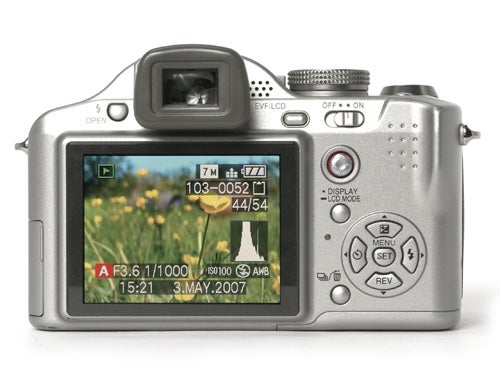
In high-speed burst mode the FZ8 can shoot five frames in a little over two seconds, although with a decent memory card there is only a pause of about two seconds before it can shoot another burst. In unlimited continuous mode it’s not much slower. With a standard memory card it shoots the first ten frames at around two frames a second, but then slows down as the buffer fills up, managing 20 shots in about 15 seconds. Using a faster memory card significantly improves this performance, allowing continuous 2fps shooting. The FZ8 is compatible with SDHC cards as well as standard SD.
The FZ8 has an unusual selection of focusing modes. It has five-point wide area, centre-spot, a wider centre area, as well as centre and three-point high-speed options. These latter two are indeed noticeably faster, so one has to wonder why the other settings are slower. However even in the non-high-speed settings the focusing is fairly quick, and shutter lag is minimal. However I did find the accuracy of the AF system left a little to be desired, especially when focusing on nearby objects. It would frequently miss foreground subjects and focus on the background instead.

The FZ8 is designed as an enthusiast’s camera, and is well equipped with useful features. I’ve already mentioned the full range of manual exposure options, as well as spot, centre-weighted and evaluative metering. The range of available shutter speeds and apertures (8-1/2000th of a second, f/2.8-f/8.0) is not as wide as I would have hoped, although the manual control system, with a separate mini-joystick for adjusting exposure and focus settings, is quick and intuitive. As well as the manual options there is an easy “auto-everything” mode, and a range of 20 scene modes covering all the usual situations. The only unusual one is an aerial photography mode, which is really just a suppressed flash setting for shooting through glass. Contrast, sharpness, saturation and noise reduction are also adjustable, but only to the extent of three settings for each.
The FZ8 has a fairly standard video mode, with 30fps VGA quality and mono audio, but the zoom lens cannot be used while filming. A 1GB card provides just over 11 minutes of video shooting, or 282 shots in standard JPEG still mode.
The 2.5-in monitor screen is nice and bright, and with 207,000 pixels quite sharp too. Its side-to-side viewing angle is good, but in standard mode the vertical viewing angle, important if you want to hold the camera above your head, is relatively poor. To combat this, the FZ8 has a special high-angle mode for the monitor which changes the polarization of the LCD crystals, making the screen too bright when viewed straight-on, but much better when held above head height. The electronic viewfinder (EVF) is better than many, and with 188k pixels it is quite a bit sharper than the 115k pixel EVF of the Canon S3, but in manual focusing mode, even with the centre area is magnified to assist focusing, I found that it simply wasn’t sharp or detailed enough for accurate focusing.

I’m a little concerned by the camera’s battery duration. The FZ8 is powered by a surprisingly bulky but relatively weak 710mAh Li-ion battery, which is less powerful than the batteries in most pocket compacts. Considering the complexity of the camera and the size of the zoom lens that has to be rolled in and out every time the camera is used, this seems surprisingly small. Nonetheless Panasonic claims an impressive 380 shots per charge. I’m not entirely convinced by this, because I found that the charge meter was down to its last bar after less than 200 shots. Perhaps the battery gets better with repeated use?
One feature that I am happy to see included in the FZ8 is a RAW mode, although it does slow the shooting speed down considerably. Unfortunately the Panasonic RAW format is yet another that is not supported by Adobe Photoshop RAW converter, so you have to use the supplied conversion software, which is a bit slow and clunky. Hover it does produce good results, certainly much better than the in-camera processing.

Once again this is the downfall of what would otherwise be a really great Panasonic camera. It’s a real shame, because the FZ8 has so much going for it. It has what is arguably the best image stabilisation system on the market, allowing hand-held telephoto shots at 1/20th of a second, and a fantastic lens that produces pin-sharp detail from corner to corner, but it’s badly let down by a puny 1/2.5-in sensor that would be better suited to a budget compact, and an image processing engine that is simply not up to the job. At the maximum quality JPEG mode and the minimum ISO setting, image noise was visible in almost every shot, which is unacceptable in a camera aimed at enthusiast photographers. The extremely limited dynamic range meant that highlights were burned out while shadows were featureless areas of black. Overall colour reproduction was good, but there seemed to be some problem with the blue channel processing which produced very blotchy colour in mid-tone and darker areas. At higher ISO settings the results were even worse, as the frankly sub-standard noise reduction system produced a brush-like effect that smoothed out fine details in mid-tone areas despite the lens’s best efforts, while over-sharpening produced artefacts around highlights and high-contrast edges. All in all this was a very disappointing result, and wasted potential from a camera which could have been so much better.
”’Verdict”’
The Panasonic Lumix DMC-FZ8 is a well-made and sensibly designed camera with a range of features well suited to the enthusiast photographer. Its performance is a bit on the slow side, but the excellent lens and brilliant image stabilisation system more than make up for that. Unfortunately however its potentially first-class photographic results are let down by an inferior sensor and poor image processing.

”A range of test shots are shown over the next few pages. Here, the full size image at the minimum ISO setting has been reduced for bandwidth purposes to let you see the full image, and a series of crops taken from original full resolution images at a range of ISO settings have been placed below it in order for you to gain an appreciation of the overall quality.”
—-

—-
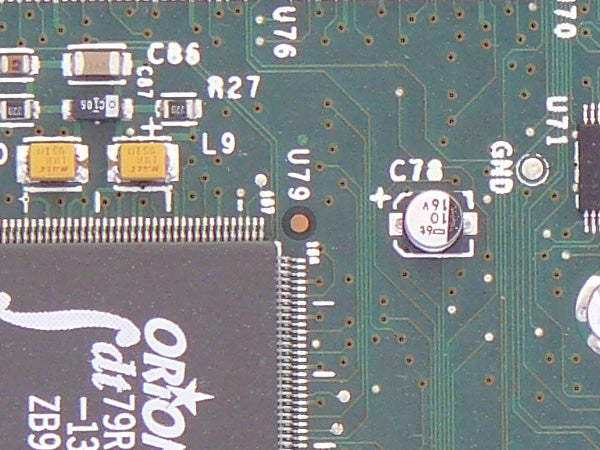
Even at the minimum ISO setting of 100, there is visible noise and colour distortion in this shot.
—-

The colour distortion is noticeably worse at 200 ISO.
—-

At 400 ISO the noise reduction system kicks in and reduces the colour distortion, but at the expense of fine detail.
—-

Again, there is less colour distortion at 800 ISO, but the noise reduction causes an odd mottled pattern across the entire shot.
—-
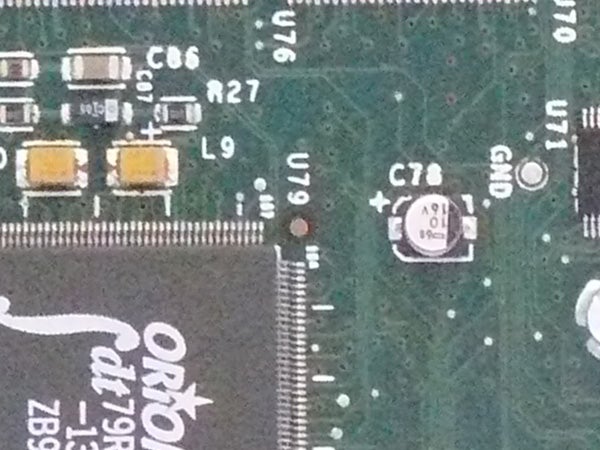
Fine detail has again been lost at the highest manual setting of 1250 ISO.
—-
”A range of test shots are shown over the next two pages. Here, the full size image has been reduced for bandwidth purposes, and in some case a crop taken from the original full resolution image has been placed below it in order for you to gain an appreciation of the overall quality.”
—-
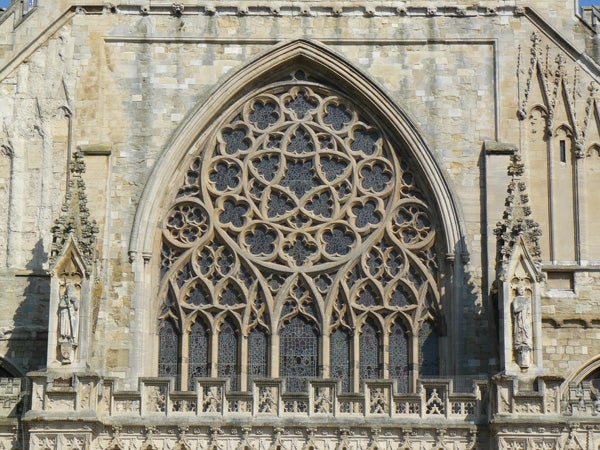
Here’s the usual comparison shot for overall detail. Either click to see the full-size image or see the crop below.
—-
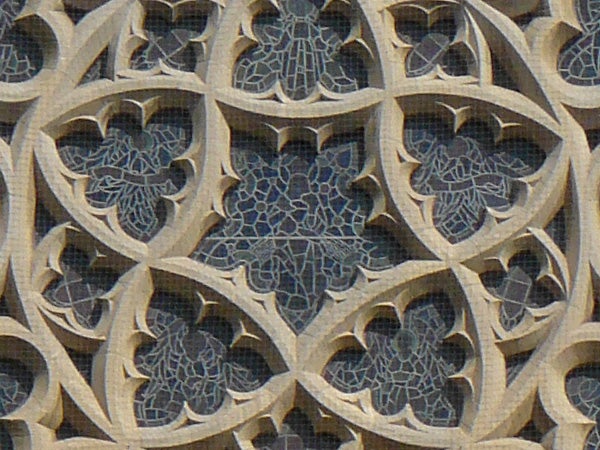
The excellent Leica-branded lens produces outstanding detail. You can practically see the knots in the anti-bird netting, but there is colour distortion and image noise visible as well.
—-

The 36mm-equivalent wide-angle end is good for general shots like this.
—-

The massive 12x zoom lens is great for picking out details from a scene. This shot was taken hand-held at 1/400th of a second.
—-
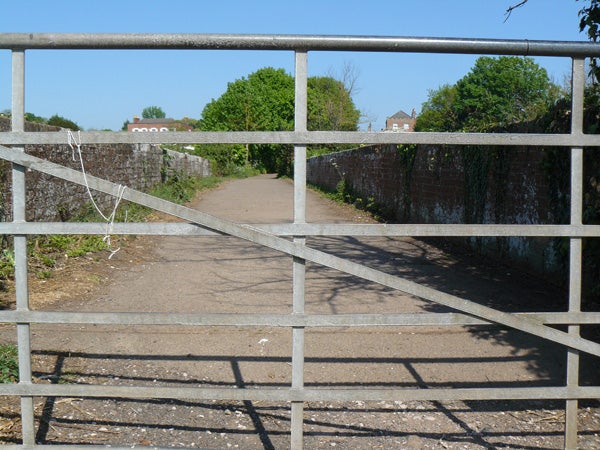
The FZ8’s lens is outstanding, producing very little spherical distortion at wide angle.
—-

Corner sharpness is also very good, in this crop from the above image.
—-

The AF system wouldn’t focus on this flower at about 20cm in macro mode, and the electronic viewfinder isn’t quite sharp enough for accurate manual focusing, but the aperture priority setting is useful for blurring tout the background.
—-
”A range of test shots are shown over the next two pages. Here, the full size image has been reduced for bandwidth purposes, and in some case a crop taken from the original full resolution image has been placed below it in order for you to gain an appreciation of the overall quality.”
—-

The overall colour reproduction is very good, except for the oddly mottled appearance of mid-tone and darker blues.
—-

Yes, it’s my car again. I’m not showing off, it’s just really good for high contrast shots. Thanks to limited dynamic range highlights are burned out, and shadow areas are featureless black.
—-
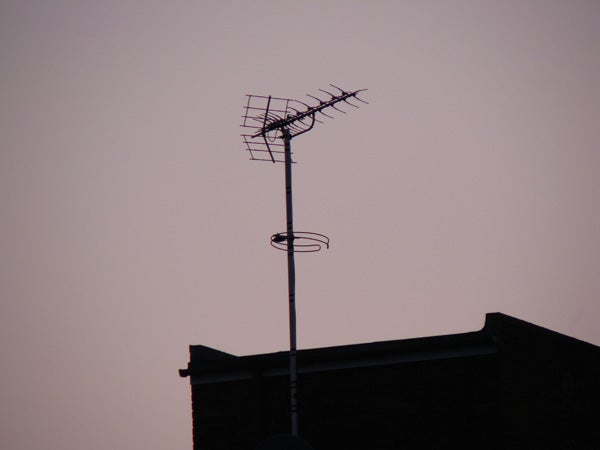
Not a particularly exciting shot, but it was taken hand-held and the maximum zoom setting equivalent to 432mm, at a shutter speed of 1/20th of a second. That’s some outstanding image stabilisation.
—-
Trusted Score
Score in detail
-
Value 8
-
Image Quality 6
Features
| Camera type | Super Zoom |
| Megapixels (Megapixel) | 7.2 Megapixel |
| Optical Zoom (Times) | 12x |
| Image Sensor | CCD |
| Image Stabilisation | Optical |
| LCD Monitor | 2.5 in |
| Flash modes | Auto Flash, Red-eye Reduction, Flash ON |
| Video (max res/format) | 848 x 480 |
| Memory card slot | Secure Digital (SD) Card, MultiMediaCard (MMC) |

